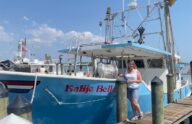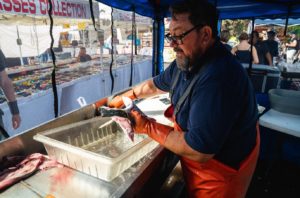If you care about marine life, you should care about California fishermen

Anyone lucky enough to sail off the coast of California or take a sightseeing boat out until the land disappears into a canvas of blue will tell you about the beauty of the ocean. Our oceans—especially off the California coast—contain some of the most beautiful sights and amazing marine life you can imagine. Not surprisingly, protection of the ocean and the organisms that dwell in it is a top priority for many elected officials and private advocacy groups.
But what unfortunately gets lost in the discussion of ocean conservation, which is many times based more on rhetoric than on data, is the fact that commercial fishing—especially the fishing that happens off the California coast—is one of the best ways to protect, preserve, and strengthen our ocean ecosystems and the marine creatures that live in them.
Since the early 1980s, California fishermen have used specialized “drift gillnets” to capture swordfish. Ever since drift gillnets came into heavy use, environmental activists have objected to their use, hyperbolically describing them as “walls of death” because other marine species sometimes become entangled in them. In industry terms, these entanglements are called “bycatch,” and it was a real problem—the key word there being “was”.
Decades ago, the drift gillnet fishery in California did have a high bycatch rate for marine mammals and other protected species. But fishery regulators then implemented a variety of measures to reduce the amount of bycatch as much as possible. Mitigation efforts, such as planned fishing limits when bycatch would be most likely, and the use of acoustic pingers on nets to scare away whales and turtles, have reduced bycatch so much that, according to the National Marine and Fisheries Service, “no [Endangered Species Act]-listed marine mammals have been observed caught in the [drift gillnet] fishery since the 2010-2011 fishing season and no listed sea turtles since the 2012-2013 season.”
Substantial progress has been made at reducing drift gillnet bycatch thanks to the diligent efforts of commercial fishermen. After all, a healthy, productive fishery is good for the long-term prospects of the fishing business, so fishermen have a strong incentive to do everything they can to ensure reasonable levels of protection for the aquatic ecosystem.
Unfortunately, when it comes to setting actual policy—especially environmental policy—rhetoric is often more effective than data. Lobbying by environmental groups resulted in the California legislature enacting a law in 2018 to ban the use of these nets by January 2024. Similar lobbying efforts resulted in the Pacific Fisheries Council’s 2015 decision to recommend federal imposition of draconian limitations on the fishery. Pacific Legal Foundation (PLF) is currently challenging both the state law and the new federal regulations in separate federal lawsuits.
Since drift gillnets are the most efficient and cost-effective way to catch swordfish, the outcome of these rules is predictable: the commercial swordfish fishing industry along the Pacific coast will essentially have to shut down for good.
That’s obviously bad news for the commercial fishermen. They’ll see their livelihoods and way of life destroyed virtually overnight. But shutting down the commercial fishing of swordfish along the California coast could potentially be a death sentence for much of the endangered marine life that these bans were designed to protect. Why? Because if swordfish fishing in America is effectively banned, the demand for swordfish will shift to other less well-regulated international markets where a sustainable approach to commercial fishing doesn’t exist.
This shift in demand is called “conservation leakage,” and it’s a phenomenon that, according to a 2017 article in Marine Policy, occurs “when domestic measures to conserve resources lead to negative environmental impacts from an increase in foreign production to meet persistent demand.”
The Marine Policy article notes that various studies have documented how existing mitigation measures for the U.S. swordfish fishery have already created a conservation leakage resulting in net environmental harm. For example, the 2001 to 2004 closure of the Hawaii swordfish fishery resulted in an increased demand for swordfish from Ecuador and Panama, resulting in an estimated net increase of 2,882 sea turtle “interactions” with drift gillnets. Conversely, when the Hawaii swordfish fishery was reopened from 2004 to 2008, there were 1,841 fewer sea turtle net interactions worldwide because of the reduced demand for foreign swordfish. In other words, when the Hawaii swordfish fishery was closed down, almost 3,000 more sea turtles were injured or killed by foreign fishing, and when the fishery was opened back up, nearly 2,000 sea turtles were saved.
Or take the example of the Pacific leatherback sea turtle. In 2001, the federal government designated a Pacific Leatherback Conservation Area off the coast of California, which bans drift gillnets for three months during the prime fishing season. Since that regulation has been in place, 1,412 more leatherback sea turtles have been the victims of bycatch worldwide than before the regulation took effect.
No one wants to see the indiscriminate or senseless loss of animal life. But an onerous clampdown on California fisheries—and the fishermen who make their living through them—will end up hurting the marine life that we all value.
Efforts to ban drift gillnets are a lose-lose proposition. This is why PLF is working with the fishermen to challenge the attempted shutdowns so that we can protect jobs and marine life for the longer term.
***









